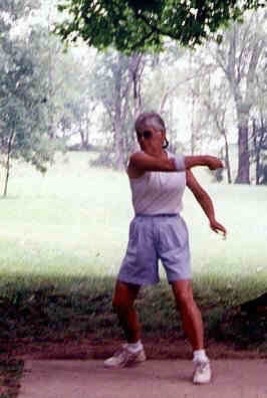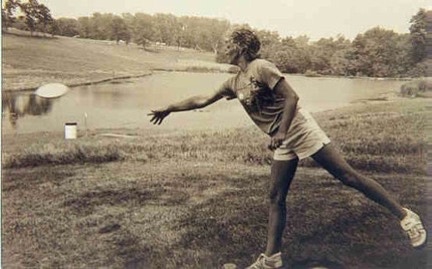Disc Golf, Techniques

Distance
Getting more distance is a prime goal for beginners, and more advanced players too. It comes with experience and practice, as the techniques are demanding and require learned skills that take time to sharpen. You don't have to be especially strong or have large muscles (or even long arms) to get fairly decent distance, as long as you learn the basic techniques.
The first principle is to keep your drive low. As in very low. About 15 feet off the ground, which is lower than you think! This allows the disc to remain flat, and get excellent lift from the air that it is passing through. Higher shots catch air with the tailing edge, which drags your disc to a halt!
Principle number 2 is to put maximum spin on the disc as it leaves your hand. The spin stabilizes the flight (through gyroscopic force) and keeps the disc perfectly positioned in the air, to maintain that perfect lift you got in principle number 1. This gives you a very long hang time, even though you are only 15 feet off the ground. Spin is created by the snap of your wrist as you whip the disc across your chest, bending your elbow to the max, then suddenly extending. The uncoiling effect snaps your wrist, propelling the disc forward, yet your tight grip with your fingertips opposes the forward motion until the last instant when momentum of the disc finally overcomes the grip. It is that explosion of opposing forces that creates the snap and puts spin on the disc.
These two principles are the main thing to learn. The rest is just a little extra you can learn later.
Extra tips:
1. Practice distance in a big field every day.
2. Take a few steps as you are throwing to get your momentum going forward. A big run-up is not necessary and can throw off your aim severely.
3. There are many discs that will go far. Try a few and see which you are the most comfortable with.
4. Hyzer (tilting the disc to the left or right) will cause your disc to fall to that side. This severely reduces your distance. You will use hyzer later on for making curving shots, but first get your distance working.
5. When you practice, try to notice what went wrong (or right!) with each shot: nose up, nose down, hyzer, flutter, slow spin, too high, etc.

Release the disc flat.
I am throwing an orange disc, seen just below my left hand in the photo. It has very fast spin, yet no flutter, so it glides through the air like an airplane wing. Even though I am throwing it slowly, and only about 4 feet off the ground, it made it easily to the basket beyond that big tree.

Start with full arm extension.
Sylvia first draws the disc as far back as possible, with her elbow straight, then pulls the disc across her chest bending her elbow to the max as the disc barely misses hitting her chest and shoulders. This is a lawnmower-yanking type of motion, but don't stop there! Keep the disc moving fast as it passes your chest, then fully extend your arm again in the direction of the throw. Grip tight so it snaps out of your fingers, putting on maximum spin!

A few steps add momentum!
Just a few steps, in a scissors motion, adds pretty good momentum to your disc. Start with a half step with your "plant foot" (right foot for right-handed throw), then swing your other foot behind your plant foot, then a large step forward with your plant foot. Your plant foot should hit the ground just before you start to pull the disc across your chest.
Grip

There are basically two effective grips: pinch grip, and power grip. The pinch grip gives greater accuracy, and should be used for putting and approach shots. With smooth technique, the pinch grip can also be used for power shots and will yield greater accuracy. I use the pinch grip for all shots, and can reach up to 400 feet. Most other top pros choose to get a bit more distance by switching to a power grip for most of their long drives.
Never put your index finger outside the rim of the disc! This takes away your most powerful and accurate finger!
Pinch grip is done by pinching the flight plate between your thumb and fingers, then bend your index finger until it catches the inner edge of the rim.

The power grip places all four finger tips just inside the rim, and the tip of the thumb on the outer edge. This gives greatest leverage for a powerful release.
Putting
Good putting will improve your score better than any other part of your game. The putt is a totally different type of throw, which starts with the arm extended in the direction of the target, then bend your elbow only half way, and then fully extend toward the target as you uncoil the wrist. You will still give it snap and a huge amount of spin, assuring that it glides in a low line drive type flight. That way, you never go too high or too low! It just remains at the mid-chain height off the ground. Of course longer putts will require a bit of loft, but that will come with practice.
The putt will feel more like a toss, as you square off to the basket, rather than turning to the side as during a regular throw. Your feet can be "plant foot forward" and push off with the other foot, or use a "straddle position" with both feet equally distant from the basket. You should practice both stances equally, since many situations will require a straddle stance. Also, doing straddle putts strengthens your wrist, and makes your other putts more sure.

Use a pinch grip for putting, so it will always feel comfortable and consistent with your other short game throws.

Practice putting every day.
Here you see me in a straddle stance, while Sylvia is pushing off with her left foot and has her right foot planted on her lie. With a straddle stance, either foot can be on the lie, giving you many options in your line to the basket. This is especially handy if there are trees between you and the basket.
To make putting practice interesting, try making up games like HORSE, or other variations.
We throw two putts from a mini marker. If one is good, then a challenge is made. If the other player misses both, you get a point. If he makes both, then HE gets the point. If he only makes one, no points are made. If the first player made both shots, a strong challenge is made, and he gets 2 points if the second player misses both, one point if he only misses one, no points if he makes both. First one to 10 points wins. Winner of a point gets to choose the next shot, but you lose your privilege if you miss both putts, or if the other player scores against you.

Practice different styles.
Here I am sinking a 90-foot knee putt (for deuce) during the finals of 1998 World Championship.

One step approach shot.
Short approaches can be made with both feet planted. Longer approaches might require a one or two step run-up.

Push off for longer putts.
Here is Sylvia sinking a 40-footer during a tournament. She is pushing off with her left foot to provide the power to get the putt into the chains. If you are farther than 10 meters (33 feet), it is OK to fall forward, follow through, or actually jump forward, as long as you release the disc before you touch down. Also your plant foot must remain on your lie until you release the disc.
Preventing Injuries
Disc golf is great as a lifetime fitness sport because there are not many injuries associated with it. With a little care, you can avoid getting any injuries at all. I have seen several potential injuries in disc golf competitors, and have learned ways of avoiding these injuries.
Lacerations
Getting hit with a golf disc can cause serious injury such as lacerations. ALWAYS practice golf courtesy by waiting to throw until the fairway is clear. Teach children that golf discs are potentially dangerous, and to be careful with them. Children under 12 should use light-weight discs (around 90 grams) with blunt edges, such as a PoleCat (made by Innova Discs).
Tendonitis
The classic "tennis elbow" tendonitis at the outer aspect of the elbow can be painful and restrictive. Be sure to stretch your tendons before, during and after your game, by straightening your elbow, then use your opposite hand to add pressure to your wrist so that it flexes (bends) your hand and wrist fully for several seconds. If you are getting some pain, use ice often to reduce inflammation. Take an ice cube in your opposite hand and rub it on your elbow until it is entirely melted. Hold the ice cube in a cloth to keep your fingers from getting too cold. If you don't apply the ice directly to your skin, it won't get cold enough.
Some players use elbow bands to apply pressure to the tendon. This will restrict the motion so that you don't use it as much, but will not reduce inflammation, and ultimately will not help the problem. This is an injury of overuse, and sometimes the only treatment is not to use your arm for a few weeks.
To prevent tendonitis, you will need to increase the strength of your forearm muscles. This is done using an elastic band, such as an Equilizer®. Hold one end under your foot and grasp the handle with your palm facing downward. Cock your wrist as far back as you can, then raise your arm to the level of your shoulder keeping the elbow straight. Now very slowly let your wrist go forward and down over a count of 10. This is called a "lengthening contraction" which is what your forearm muscles need. DO NOT exercise your arm with "shortening contractions" since this will make your tendonitis worse.
Blisters
A hard snap or release from your hand can result in extreme friction on your skin, and can result in blisters. If you notice certain places on your fingers that get sensitive or red, use paper tape to wrap around your fingers during the round. If you wrap twice around, it will provide good protection, yet will be thin enough to maintain your sense of touch and accuracy. I have found that 3M brand paper tape works the best for this. Any drugstore has this in the bandaid section.
Back Pain
Back pain is a common result of just about any activity, especially if you are not stretching or are sleeping on a soft mattress. Being overweight is another risk factor for back pain, so it might be time to shed a few pounds. Definitely do some back stretches before throwing, and during the round as well if you feel some tightness. If you have any shooting pains down your leg, or weakness in your feet or ankles, you need to see your doctor, as this might be a sign of sciatic nerve damage due to a herniated disk in your spine.
Foot Care
Take care of your feet! Many courses are rocky, hilly, uneven and very long. This can take a toll on your feet. Wear heavy socks and adequate shoes. Changes socks if they get wet. I recommend double socks, such as WrightSock or others. If you do get blisters during competition, use moleskin to pad them.
Aussie Golf

Aboriginal frisbee.
